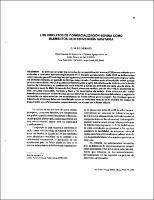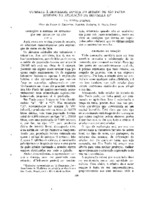Comportamiento epidemiológico de la rabia paralítica bovina en la región central de México, 2001–2013
Date
2015Author
Metadata
Show full item recordAbstract
Objetivo. Determinar la distribución geoespacial de los casos de rabia paralítica bovina transmitida por Desmodus rotundus en los estados de Guanajuato, Querétaro y San Luis Potosí, México. Métodos. Estudio epidemiológico transversal a partir de los casos notificados por las campañas estatales de control de la rabia paralítica bovina en Guanajuato (2008–2013), Querétaro (2005–2013) y San Luis Potosí (2001–2013). Se confirmaron los casos por inmunofluorescencia directa. Se elaboraron mapas de distribución de los casos por año y por especie, mediante el software ArcMap versión 10.1. Para identificar áreas con condiciones apropiadas para la presencia de casos se combinaron las variables bioclimáticas con los casos georreferenciados, mediante el programa MaxEnt versión 3.3.3. Resultados. Se registraron 1 037 casos, de los cuales, 911 (87,9%) ocurrieron en San Luis Potosí, 82 (7,9%) en Querétaro y 44 (4,2%) en Guanajuato. Del total, 87,4% ocurrió en Alturas menores de 1 500 msnm. En Guanajuato y Querétaro, 77,3% y 42,3% de los casos, respectivamente, ocurrieron en alturas mayores de 1 500 msnm. Los meses de mayor incidencia fueron de diciembre a marzo. La variante antigénica viral V11 fue la más frecuente (173 casos), presente en los tres estados estudiados. En el canal endémico, el promedio de casos se mantiene en la zona de seguridad de enero a marzo, pero de abril a junio excede la mediana. La distribución espacial de los casos muestra la diseminación reciente de la enfermedad, lo que coincide con la presencia del murciélago vampiro. Conclusiones. La rabia paralítica bovina se ha extendido a regiones anteriormente libres de esta enfermedad. Las características ambientales y la altura sobre el nivel del mar no limitan la presentación de casos. Se debe mantener un monitoreo constante para la detección oportuna de casos. La vacunación se debe realizar antes del comienzo de las lluvias, sin esperar la aparición de brotes. Objective. To determine the geospatial distribution of bovine paralytic rabies cases transmitted by Desmodus rotundus in the Mexican states of Guanajuato, Querétaro, and San Luis Potosí. Methods. This was a cross-sectional epidemiological study based on cases reported during statewide campaigns for the control of bovine paralytic rabies in Guanajuato (2008–2013), Querétaro (2005–2013) and San Luis Potosí (2001–2013). All cases were confirmed by direct immunofluorescence. Maps showing the distribution of cases by year and species were constructed using ArcMap version 10.1. To identify areas where conditions favor the appearance of cases, bioclimatic variables were combined with georeferenced cases using MaxEnt version 3.3.3. Results. Of the 1037 cases recorded, 911 (87.9%) occurred in San Luis Potosí, 82 (7.9%) in Querétaro, and 44 (4.2%) in Guanajuato. Of the total number of cases, 87.4% occurred at altitudes of less than 1500 meters above sea level. In Guanajuato and Querétaro, 77.3% and 42.3% of the cases, respectively, occurred at altitudes greater than 1 500 meters above sea level. Peak incidence was recorded from December to March. The V11 antigenic variant of the virus was the most common (173 cases); it was found in all three states. In the endemic channel, the average number of cases remains within the security zone from January to March but exceeds the median value from April to June. The spatial distribution of cases shows that the disease has spread recently, which correlates with the presence of the vampire bat. Conclusions. Bovine paralytic rabies has spread to areas that were formerly free of the disease. Environmental characteristics and the altitude above sea level do not limit the appearance of cases. Constant monitoring should be conducted for early case detection. Vaccination should take place before the rainy season starts, without waiting for outbreaks to occur.
Translated title
Epidemiological trends in bovine paralytic rabies in central Mexico, 2001–2013
Subject
Citation
Bárcenas-Reyes I, Loza-Rubio E, Zendejas-Martínez H, Luna-Soria H, Cantó-Alarcón GJ, Milián-Suazo F. Comportamiento epidemiológico de la rabia paralítica bovina en la región central de México, 2001–2013. Rev Panam Salud Publica. 2015;38(5):396–402.
Collections
Related items
Showing items related by title, author, creator and subject.
-
Moraes, G. M. (OPSBrazilRio de Janeiro, 1993)Se definen y evalúan los circuitos de comercialización bovina (CCB) como método para entender e intervir epidemiológicamente en el espacio agropecuario. Cada CCB se define como aquel espacio geopolítico integrado por agentes ...
-
D'Apice, Mario (s.d.)Under the prevailing economic conditions in the State of São Paulo, bovine brucellosis cannot be successfully eradicated by the test-and-slaughter method. As a matter of fact, this method was tried a few years ago in some ...
-
Barberato-Filho, Silvio; Bergamaschi, Cristiane de Cássia; Del Fiol, Fernando de Sá; Antoniazzi, Felipe Bernardini; Stievano, Julia Módolo; Justo, Ana Celine; Souza, Camila de Paula; Silva, Marcus Tolentino (2020)[RESUMO]. Objetivo. Determinar a prevalência de Staphylococcus aureus resistente à meticilina (MRSA) em animais destinados à produção de alimentos na região das Américas. Métodos. Foi realizada uma revisão sistemática nas ...




